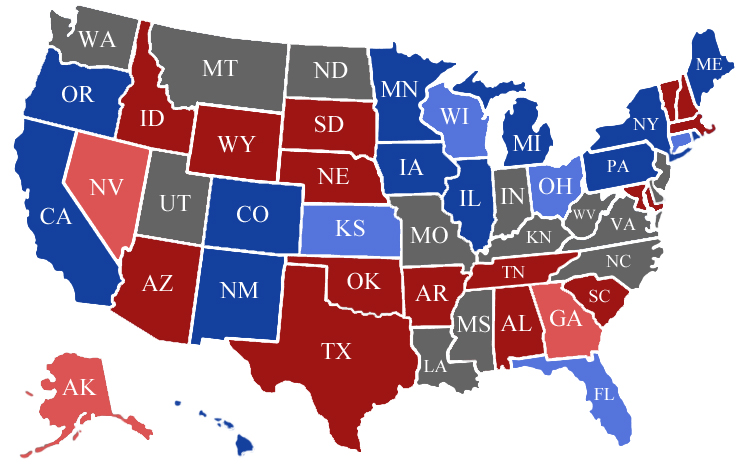Carter Hanson’s Official Election Predictions #2 – The Governors
November 2, 2018
Hello again! I hope you enjoyed my take on the Senate yesterday and I’m back with my official predictions for the 36 gubernatorial elections happening all over the country in just four days.
If you didn’t read my Senate predictions from yesterday, you can do so HERE.
Anyway, without further delay, I’ll begin.
The Governors

The races for governor across the nation are looking significantly better for Democrats than for them in the Senate races. Democrats look ready to pick up at least 4 states with as much as 11 within the realm of possibility to flip to the Democrats.
This election cycle, the battleground for governor (as with the House races that I’ll cover tomorrow) has been pushed back into solid GOP territory. Democrats are on the offensive, forcing the competitive races back into states like Georgia, Wisconsin, and Kansas where the Republican Party traditionally has hegemony, especially in the race for the governor. In the governor map you can really see the “blue wave” in effect: Democrats have resurged in the industrial midwest, likely to triumph in Iowa, Illinois and Michigan, unseat somewhat popular incumbent Republicans in states like Wisconsin, and compete in not just normal swing states, but also lean and likely Republican states.
Having said that, the map looks great for Democrats. Let’s dive into some of the individual battlegrounds and I’ll explain my prediction in greater detail.
The five states to watch on election night are Nevada, Georgia, Wisconsin, Kansas and Ohio. All five of those, except for Nevada, voted for Trump in the 2016 election. Alaska and Connecticut are also worth watching as they too are in the category of “swing” races, but I don’t see a clear enough way for Democrats to win in Alaska—or Republicans to win in Connecticut inversely—to go too much in depth on these races.
Anyway, Nevada, Georgia, Wisconsin, Kansas and Ohio. Wisconsin, of the five swing seats, has the most obvious likely outcome: I forecast that Democrat Tony Evers will defeat incumbent Republican Scott Walker. Walker, who’s been the Governor of Wisconsin since 2011, has polled relatively consistently behind Evers for the past month or so. On top of that, Walker’s incumbency advantage is lessened by his low approval rating, being on of the ten least popular governors in the United States. That low approval in a year where Democrats are resurging all over the nation (especially in swing states, especially in the industrial midwest), is bad news for governors looking to get re-elected like Scott Walker. That’s why Walker won’t win: he’s an unpopular Republican in a midwestern swing state in a pro-Democratic year.
Ohio, after a string of Republican wins in the state in recent years, looks ready to vote in a new Democratic governor. Democrat Richard Cordray is facing off Republican Mike DeWine for the position. Cordray’s team has approached the campaign focusing on the economy and jobs, a strategy that I believe will win him the election. By attacking the GOP on the economy, Cordray is able to both play to his strengths, having been the Director of the Consumer Finance Protection Bureau from 2012-2017, and play to the character of Ohio. Cordray fits the profile of Ohio because Ohio is a definitively working class state, a representative of the industrial and agrarian economic roots of the nation. Running on a platform of jobs is how you win in that kind of a state. It’s how Obama won in 2008 during the Great Recession: he ran on a platform of jobs, appealing in the process to traditionally Republican voters in states ranging from North Dakota to Missouri to Ohio.
The race in Kansas is surprisingly close, Democrat Laura Kelly even polling ahead of Republican Kris Kobach in the past few weeks. They’re running to replace Republican Sam Brownback an extremely unpopular governor who essentially destroyed the Kansan economy through a series of tax cuts that forced the state government to deficit spend and caused a fiscal crisis. This culminated in the Republican controlled state legislature rolling back Brownback’s aggressive tax cuts. This leaves the door wide open for a Democrat to challenge in this consistently Republican state. I believe that Brownback’s legacy will allow Kelly to win, despite the significant disadvantages she faces in terms of the state’s partisanship. Kelly is polling ahead, albeit very slightly, and I think she can pull through and win.
I’ve put it off long enough and know I have to face the consistently inconsistent state of Nevada’s race for governor. To be honest, I don’t know as much about this competition but, after registering the fact that neither party’s candidates seem anything near extraordinary, I feel fairly confident in predicting a Republican victory. Nevada’s electorate is unique: a combination between Arizona and Colorado in a way. It paradoxically votes invariably for Democrats for president and Republicans for most other statewide races. It’s House delegation split among parties. It is one of the few remaining western swing states. However, as I mentioned in yesterday’s article, Democrats need minority turnout in order to win in a non-presidential election year. And thus far, I haven’t seen that to the point necessary for Democrats to win. That’s why my forecast goes for Republican Adam Laxalt.
Finally, the race you’ve all been waiting for. The most interesting gubernatorial election of 2018: Georgia! It’s Democrat Stacey Abrams against Republican Brian Kemp, a battle between the first African-American woman State House Minority Leader in Georgia’s history and a Trumpian State Secretary of State. This race is almost exactly a tie: I really have no idea who will win, although I give a slight edge to Kemp. I also can’t do justice to the turbulent and fascinating course this battleground has taken in a short article, the clash of campaign strategies dividing both parties, the invective and divisive nature of the race and the actions of Kemp, who is ironically in charge of the election, which border on mass disenfranchisement of African-Americans.
One thing is clear though: a competitive race of this caliber conducted by an African-American woman in Georgia could only be a Republican nightmare a few years ago. A new force has taken the reigns of the Democratic Party in this election cycle and the GOP—as well as the old Democratic leadership—doesn’t know how to react. The face of the party is changing, reflecting its supporters identities, values and character more and more with every woman, African-American, Latino, and LGBT person who gets elected. That’s what I take away from this race: more so than any other time in our lives, a new generation is taking the torch, a generation of public servants that reflect their constituents.
And that, I believe, is an inspiring thought indeed.
Join me tomorrow for my take on the elections for the House of Representatives.















Leslie Miller • Nov 2, 2018 at 8:20 PM
Cordray…former neighbor!